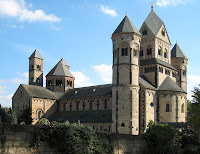Architecture has always been a major form of art. It has been used to express culture and wealth of a society. The Romanesque architecture was represented as protective and sturdy to withstand any attack. Gothic architecture was shed a new light on the world, especially when it came to expressing art through the Catholic Church. The structures were beautifully made and offered the light to be shared. The spread of Christianity had an influence on the world, especially on Romanesque and Gothic architecture; it expresses how the people preached and prayed to God.
Romanesque architecture started around the ninth century and ended during the eleventh century. The structures were designed to keep people safe and in solitude during prayer. The thick walls drove unwanted forces away and gave the people inside a sense of comfort. The Gothic walls were designed to be thinner, so windows could be built and allowed light to shine. Figure 1, the St. George rotunde, is an example of the sturdy, thick walls that kept the people inside its walls sheltered. Figure 2, St. Denis Chorumgang, is an example of the change in structure of the cathedrals. The stain glass windows and columns were new and added beauty to the house of worship. Romanesque churches did not have windows on the first floor because there was a risk of people invading. The people who prayed within the walls were looking for confinement. The change in design of the cathedrals allowed more light to shine on those who prayed to the Lord. During the eleventh century, a large number of churches increased all across Europe, and that was the start of the new idea to put more time and effort into building a holy place for worship.
As Europe began its reformation, more money was available. Figure 3 (St. Andrew's Church) was built during the Romanesque period and was mainly composed of brick and wood. Figure 4 (Cathédrale de Reims) can be viewed as looking very detailed and expensive. The stain glass windows were a new addition because the church had a bigger budget. The columns support the ceiling and arches. The walls are visibly thinner unlike the Romanesque church. The brick walls of St. Andrews offered tended to those who wanted to pray by eliminating the outside world. The Gothic cathedrals represented the change in the economic situation and allowed more opportunities for the church to improve their houses dedicated to God.
The spread of Christianity soon overtook Europe and polytheism was soon forgotten. After the Catholic Church was established by Jesus Christ, more people wanted to learn more about God. The church was the center of the community where everyone came together for a common purpose. The Maria Lach (figure5) is a more detailed Romanesque church that was later designed for more space for the congregation of the church. The Notre Dame Cathedral (figure 6) shows that the church had grown far and wide and more people were seeking to worship the Lord in a holy, sacred place. Each cathedral drew the community grew people closer together. The bishop ordered the construction of Notre Dame in the mid eleventh century, but it took decades to build. Still standing today, the church draws people far and wide to admire its beauty. Every church has a common purpose and is used daily.
In conclusion, churches have been around for centuries but the design of each one is different. The Romanesque churches were built with thick to keep enemies out and were a place of solitude. The Gothic cathedrals were beautifully crafted and let the light of God shine into the church. A modern example of how Gothic architecture still has an impact on the world is the Loyola University chapel in Baltimore. Art has evolved and changed for the Catholic Church, but the love for God remains the same.
Appendix
Figure #1-Saint George, rotude http://commons.wikimedia.org/wiki/File:Rotunde-of-St.-George-at-Rip.jpeg , photograph take June 8, 2005
Figure #2- St. Denis Chorumgang, interior, http://en.wikipedia.org/wiki/File:StDenis_Chorumgang.JPG, photograph taken April 29, 2005
Figure #3-St. Andrew's church, façade, http://commons.wikimedia.org/wiki/File:St._Andrew%27s_church_facade_(Krak%C3%B3w,_Poland).jpg , photograph taken April 7, 2006
Figure #4-Cathedrale de Reims, interior, http://en.wikipedia.org/wiki/File:Cath%C3%A9drale_de_Reims_int%C3%A9rieur.jpg, photograph taken March 18, 2007
Figure #5-Maria Lach, cathedral http://commons.wikimedia.org/wiki/File:Maria_Lach_02.jpg, photograph taken April 28, 2008
Figure #6-Notre Dame, cathedral http://en.wikipedia.org/wiki/File:060806-France-Paris-Notre_Dame.jpg, photograph taken August 6, 2006






No comments:
Post a Comment